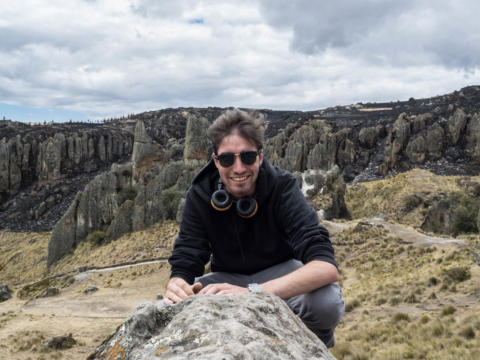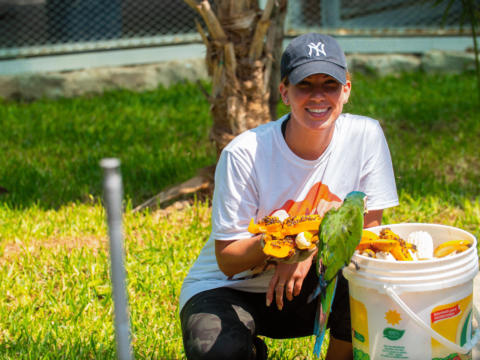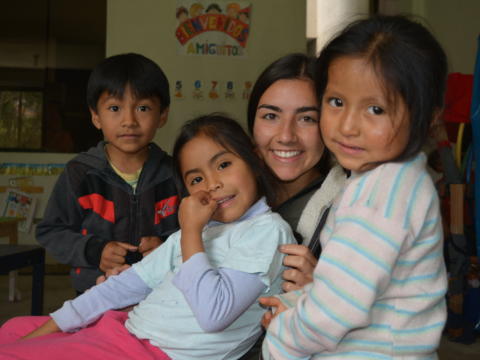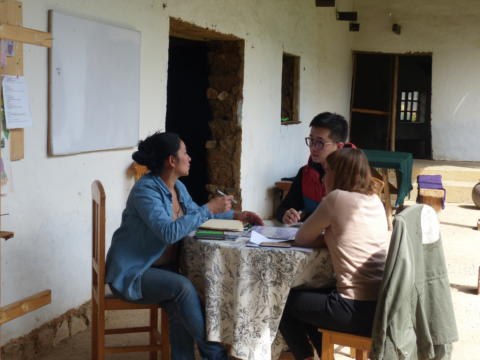Only 360€ per week!
Teaching Internship
Cajamarca - Peru
Encounter Peru’s education system while teaching English in a local private school to get foreign working experience.
While living in Peru, collect a professional qualification for your career with a real working environment in a school in Cajamarca (kids 7 to 15teen) with immense opportunities to enhance your career in education. This international experience will enable you to expand your knowledge and expertise as a teacher in English.
Program Description
This is an ideal opportunity for individuals with an academic background in education and teaching to enhance their career with experience in a foreign working environment.
You will be placed in schools in Cajamarca where you can learn about the education system in this country while you will also be able to share your knowledge and ideas with the local teachers in your school.
You will have the opportunity to work with private schools. You will be working alongside a supervisor who will guide you through your internship and assign you your tasks, roles and responsibilities during the internship.
You will first assist your supervisor in teaching. You will be given different tasks according to your interests as well as vision. You will also create your own lesson plans for your class following the school’s syllabus.
The challenging part would be that some of the students may not be able to understand basic English spoken but the majority of them have English beginner’s knowledge.
Cultural Introduction
The first week of your internship is composed of an introduction to the local culture, customs, dos and don’ts. Not only will you get to learn about the language and lifestyle, but you will also visit and see the city and will learn to get around the place on your own. Being one of the most popular cities in the north of Peru, Cajamarca offers unique internship experiences with lots to see and visit!
During the first 3 days from Monday to Wednesday, you will get to know the life and style of Cajamarca and what to expect during your internship. Your internship coordinator will show you around the city and will give you tips and tricks you must know when in Cajamarca.
From Thursday to Friday on your first week, you will receive an academic introduction session before the internship. During these sessions, a professional supervisor will educate you about the local situation and developments surrounding the industry/field in which the internship takes place and prepares the intern for the local work environment/culture.
What’s included
- Guaranteed internship placement with an assigned project and a professional work environment
- Guaranteed English language speaking person in the working environment plus a local language when applicable
- Pre-internship personal learning goal and competencies assessment
- Guidance, Supervision and on the job training
- Guaranteed 25+ working hours per week
- Frequent (bi-weekly/monthly) feedback and progress sessions with the hosting company/organization
- A mandatory introduction week consisting of an intro into the local culture and customs as well as an introduction into the internship placement
- 24-hour local support
***All participants must have a sense of initiative and understand that teachers at the project might not speak the same language***
Aims & Objectives
- Career development for young teaching undergraduate individuals, by applying and progressing their skills in a foreign working environment.
Schedule
Monday to Friday
After breakfast, you will leave for your placement to start your day’s work. You will be assigned to your teaching sessions/classes based on your experience and field of expertise.
Your role and daily tasks will be allocated depending on the teaching assignments you will get.
- You will start work in the morning and your teaching will continue until the afternoon. Evening classes will be scheduled depending on the requirements of the school.
- Your teaching schedule will depend on your field of specialization. You will teach different classes and different age group students at the school.
- You will also assist other teachers in creating lesson plans and teaching materials.
Note: This schedule can be changed and/or amended depending on weather conditions, local conditions and unforeseen circumstances.
Participant Criteria & Requirements
Standard Requirements
Minimum age: 18
Maximum age: –
Minimum English level: Advanced
CRB required: On Signup
Passport copy required: On Signup
Resume copy required: On Signup
Required qualification: Academic qualifications in a related field
Additional Requirements
- An established background in an affiliated field of study related to education.
- A reference letter authorized by your university you are presently working/studying at.
- Proof of qualifications and CV/Resume and a copy of your passport sent by email to the local team at least four weeks before beginning the internship
- Motivation letter including learning goals, expectations and specific placement requests from the intern
- Copies of certificates of qualifications and academic transcripts
Additional Equipment
Required
- Formal dress is appropriate during your time at the project. However, no see-through clothes or low cut tops are permitted.
- A laptop
Optional
- You are more than welcome to bring teaching materials/resources for your class such as:
- Interesting board games
- Books/Comics
- Musical instruments
- Worksheets
- Cultural items of interest
- And anything else you think will help!
Location
you will be staying in the district of Puyllucana which is a small village found in the east-northern part of Cajamarca.It is a beautiful location with great weather and friendly locals.
Located only a short distance away from Cajamarca city (Capital and largest city of Peru’s Cajamarca Region, enriched in culture and history), this quiet location provides a relaxing atmosphere after a day out. The accommodation has a beautiful view of the Andes Mountain Range and is close to the Amazon Rainforest, it will bring you back to South American nature!
About the Accommodation
You will be staying in our accommodation center in Puyllucana, Rural Cajamarca countryside. The house is made with traditional materials such as adobe and stone, it also has a large garden. Wi-Fi will be available only in common areas. We recommend also using 3G data if staying connected is important to you.
All participants are expected to be environmentally aware and to use all resources with restraint, especially water, paper and electricity. Although rooms will be cleaned daily by staff, you will be expected to clean up after yourself, and to play your part to keep accommodation neat and organized.
Food Arrangements
The food will be typically Peruvian meaning lots of corn, beans, rice, chili peppers, potatoes, wheat, and other grains, all very vegetarian friendly. Keep in mind that some local dishes may be spicy!
Facilities
Eateries
Although there are many restaurants around this small town, “Menu centers” are a cheaper popular local choice. Known as a “Menu”, here you are offered soup and entrees before digging into your main meal and are usually accompanied by a drink, usually made from barley or tropical fruit. Menus have a smaller range of food, but are cheaper and more convenient. They act as the ‘fast food’ for the locals, who tend to dislike western fast food outlets.
Shops
Local shops are within walking distance. A short walk from our accommodation site will bring you to convenience local shops, for all your immediate shopping needs
Transportation
Our accommodation is about 3.10 Km from the main square of Baños del Inca. This is roughly 8 km, about 30-40 minutes away from the Cajamarca city center by public transportation.
“Moto-taxis” are also available for quick rides around town (up to 3 people round trip cost Banos del Inca 2 – 3 soles)
Internet use
There is Wi-Fi in your rooms as well as public areas at your accommodation, but there is also an internet cafe in the main township where you can access wifi from when you are not at the centre.
Money
There are numerous shops and ATMs in the center of town.
Medical
We will have a basic first aid kit on site, but there is a clinic available in Banos del Inca. A hospital and various clinics are in nearby Cajamarca for any emergencies or health issues that may arise.
Activities & Events
Cooking Lessons
Daily: Evenings
Join your cook as they prepare meals for you and other participants. Take notes, learn new recipes, traditional food preservation techniques and more! Try not to spoil your dinner as you learn!
Farm Animals
Daily: Mornings and Evenings
Watch the local farmers near your accommodation, as they tend to their animals in daily rituals like shearing and milking.
Sights & Surroundings
Chiclayo
You can easily reach Chiclayo, Peru’s fourth biggest city, by public transport which is cheap and frequent. Chiclayo offers shopping centers, a cinema and nightlife, but it is also a major traffic hub in northern Peru. This makes it easy to travel on the weekends or after your program.
There are plenty of small restaurants or shops around the area. There is an active surfing community and it is easy to make local friends, we can also point you to our Tandem Skydiving program and some other events.
Huanchaco
Only 12 km outside Trujillo. Once a quiet fishing hamlet, the town is now one of the best places for surfing.
Trujillo
Founded by Francisco Pizarro in 1534, Trujillo has 709,500 inhabitants. It is the home of the beautiful Plaza de Armas and its glamorous colonial. 4 hrs from our accommodation, this city by the ocean is referred to as the everlasting spring, where temperature is usually 32ºC, and where the very important Festival de la Marinera takes place.
Having said that, the main reason why most people pass through this coastal city is to visit one of Peru’s top-attractions: the Chimú adobe city of Chan Chan.
Chan Chan
Built around AD 1300, Chan Chan is the largest pre-Columbian city in the Americas, and the largest adobe city in the world. You can visit it by taking a combi from C/España. The ticket (10 S) includes entrance to the Nik-An temple, the Chan Chan museum, the Huaca la Esmeralda and the Huaca Arco Iris.
A bit further from the city, the Huaca del Sol y la Luna is over 700 years older than Chan Chan and belongs to the Moche culture. The temple is filled with icons representing Ai-Apaec, the god of the mountains, feared for provoking phenomena like El Niño. To stop him from sending heavy rains, the Moches would offer him human sacrifices.
Kuntur Wasi
The ruins of a religious structure in Peru’s northern highlands only 2 hours from our accommodation.
Cajabamba, Huamachuco
Located 5 hours away is a northern Peru town, rich with history, politics, religion, culture and hometown of the international famous muralist Jose Sabogal. Here, you can also visit unspoiled archeology sites and old monuments.
Bambamarca and Chota
Located 3 and 4 hours away, respectively, these towns are known for their festive activities in the months of June/July.
Leymebamba and La congona
Six hrs driving up north, with a little more than 4000 souls, Leymebamba is the perfect, quiet place to try visit La Congona, it can be reached on foot by hiking uphill from Leymebamba.
Museum of Leymebamba is just half an hour walking from Leymebamba. Inaugurated in June 2000, the Museo Leymebamba displays more than 200 mummies and their burial offerings recovered in 1997 from the Laguna de los Cóndores by a salvage Project directed by Centro Mallqui. Once at risk from looters and vandals, today this valuable collection is housed in the Museo Leymebamba. An initiative of The Bioanthropology Foundation Peru-Centro Mallqui, construction of the Museo Leymebamba was made possible by a donation from a group of Austrian citizens, as well as by funds from other private donors.
Chachapoyas
Also known as the Warrior of the Clouds, the Chachapoyas were a pre-Incan civilisation who lived in the cloud forests of present-day Peru. Chachapoyas contains intriguing archeological sites to explore, however the drive is 12 hours away from our Center, so good planning will be required.
Kuelap: The second Machu Picchu
Famous fortress of the mystic “cloud warriors”. One of the very few places never conquered by the Incas. Visitors describing Kuelap indicate that it is “as impressive as Machu Picchu” while it is by far not as crowded or expensive.
The government just recently decided to invest heavily into tourist infrastructure around Kuelap. Be one of the last persons discovering it while it is still relatively unknown!
Gocta
The waterfall of Gocta (771m) is amongst the highest in the world. Although methods of measurement are debatable, it got recognized as the world's third highest waterfall, right after Angel Falls (Venezuela) & Tugela Falls (South Africa). Combine your visit with Kuelap and pick Chachapoyas as your homebase to have an adventurous weekend!
Transportation
From this location we provide free transport to your next program at the following location(s):
- Lambayeque (Chiclayo)
- Huanchaco
- Chiclayo
Quick Facts
Name: Republic of Peru
Population: 31 million
Capital: Lima
Language: Spanish (Quechua, Aymara)
Currency: Nuevo Sol (PEN)
Time zone: PET (UTC -5)
Country Information
Peru is the third largest country in South America; a country known for its incredible cultural heritage such as the renowned Machu Picchu and the remains of the Inca Empire. Although the Incas are the most famous ones, there are other manifestations of pre-Columbian cultures and unexplored archaeological sites which can be located in the North of Peru. This magnificent land composed of a variety of landscapes, climates and biodiversity, is visited by tourists from all over the world.
In Peru, it is possible to enjoy a range of activities from surfing in the Northern beaches to hiking in the Andes Cordillera, from trekking in the humid and hot Amazon rainforest to visiting cultural sites, excellent museums, and enjoying traditional dishes. Peruvian people are very friendly, warm, and ready to help or to introduce you to their customs. You will find in these regions a great diversity of ethnic groups, festivities, handcraft, and gastronomy.
Peru is a country of contrasts where the crazy traffic is surpassed by the majesty of mountain ranges. You will find cities peaking at altitudes of more than 6700 meters, infinite beaches with beautiful sunsets, the magically diverse landscape of the tropical rainforest and let’s not forget about the llamas.
Climate
Despite being near the Equator, the presence of different regions of the Andes Cordillera and the arid coast along with the effects of the cold Humboldt Stream induce highly distinct weather. The climate in Peru consists in three main regions: Costa, Sierra, Selva (the coast, the mountains and the jungle).
Costa
The coast of Peru represents 10% of the whole surface of the country. Within this part of the coast, the north has a semi-tropical climate. Because of the Humboldt Stream, the temperatures are not that hot for a desert. The temperature is around 24°C all year long. The Southern region, including the central coast and the south, has a subtropical climate. The temperatures range from 15°C during the winter to 26°C during the summer. Summer is from December to March.
Sierra
Alongside the Andes Cordillera, the winter is dry and the summer rainy. The annual temperatures fluctuate from 11 to 16°C but with wide differences from one site to another because of the different altitudes. Therefore, it is better to come during the winter from May to September during the dry season and enjoy the Costa during the summer.
Selva
This is the Amazon region of Peru that represents 60% of the Peruvian surface. The climate is humid, hot, with rainfall all year long and especially during the rainy season from January to April. During the dry season, it usually rains once per week with temperatures fluctuating around 30°C.
In any case, it is preferable to have 3 kinds of outfits for cold, hot and rainy weather. This beautiful country has different climate zones since it has deserts, mountains and Amazon rainforest.
Culture
The Peruvian culture is widely known for its Inca Empire and the ruins of Machu Picchu. However, Peru includes a lot of other different cultures that are lesser known. Before being colonized in the 16th century by Spain, and before the Inca Empire, other cultures were already very organized, structured economically and politically. This is particularly the case of the Chavín and Mochica cultures which date from 1800-200 BC. Hidden archaeological treasures of these cultures are present in the north of Peru. The Lambayeque Region is the biggest hotspot of unexplored archaeological places in the world while the south of Peru is the most touristic region with Cusco, Machu Picchu and Arequipa.
The country recognizes the practice of other religions. Nevertheless, since its independence from Spain in 1821, Peru remains mainly catholic at 80%. Therefore a lot of churches are present in the country. Inspired from the colonial style, they often constitute the sights to see, along with buildings from the same era in big cities such as Chiclayo, Piura, Trujillo, Arequipa, and Lima. Even with Catholicism as the predominant religion, several events and festivities in Peru refer directly to Inca celebrations and ceremonies. Peru is a colourful country, as evidenced by the traditional fabric you can find in the handcraft markets.
The city of Cajamarca is renowned for its carnival where paint battles take place every year. If you are out and about on those days, expect to be targeted with paint and water during the celebration. Peru is also a country of dances. The national dance is the Marinera and it is frequently practiced along the coast, while traditional tribal dances can be found in jungle areas.
Nowadays, Peru is a multicultural country due in part to the colonialism period, but also because of the different migration phases. The indigenous population represents 45% of the population while the rest is a mixture of different ascendances. A third of the population is Metis and has Spanish origins. Then there is a melting pot of European, African and also Asiatic people. The indigenous are more present in the Selva while the rest of the country is mixed with the other ethnicities. Also, in the jungle and mountains, it is more frequent to see people wearing traditional clothes such as the poncho, the hat and the long skirt for women. While the Amazon represents 60% of the Peruvian surface, it is the least densely populated region of the country. Therefore, it holds lots of beautiful unseen areas and uninhabited parts, which remain untouched by humans.
Gastronomy
Another important sector in Peru is the fruit production. Peru is a land of fruit trees, like Mango and Cherimoya, which are very tasty.
Peruvian gastronomy is award winning! Among its specialities are the Ceviche, which is made with raw fish, seasoned with lemon and spices, the Anticuchos made with beef heart, the Chicha Morada, a national drink made with purple corn, and the national alcohol: Pisco.
Peruvian gastronomy is considered to be one of the most diversified and famous in South America. Very often, dishes include rice; this may be in part because of the Chinese migration influence. Since then, “Chifa” in Peru has been used in reference to Chinese cooking.
Transportation
Public transportation in Peru is very easy and the travel costs are low. The traffic may be crazy in Lima and in general, but for long distances, the most common means of transportation is by bus and it is very safe.
Perú shares borders with Brazil, Colombia, Chile, Bolivia and Ecuador. This is great for travelers because it is very easy to combine different destinations. One such option is Peru and Ecuador, which has one of the most biodiverse landscapes in the world.





